

Using the Emergency Flat Tyre Repair Kit
-
Move the vehicle off the right-of-way to a safe place on a level and hard surface where the vehicle does not obstruct traffic.
-
Shift the shift lever to the 1 or Reverse (R) position for a manual transmission, and shift the selector lever to the P position for an automatic transmission.
-
Apply the parking brake with the brake pedal depressed and turn off the engine.
-
If necessary, flash the hazard warning lights and set up the roadside emergency triangle.
-
Unload passengers and cargo and remove the emergency flat tyre repair kit.

-
Shake the tyre sealant well.
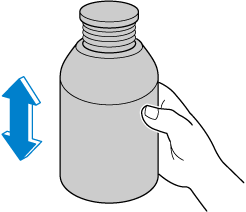
If the bottle is shaken after the injection hose is screwed on, tyre sealant could spray out from the injection hose. Tyre sealant contacting clothing or other objects may be impossible to remove. Shake the bottle before screwing on the injection hose.
The sealant hardens easily and injecting it will be difficult under cold weather conditions (0 °C (32 °F) or below). Warm the sealant inside the vehicle to facilitate injection.
-
Remove the cap from the bottle. Screw on the injection hose with the bottle's inner cap left on to break the inner cap.
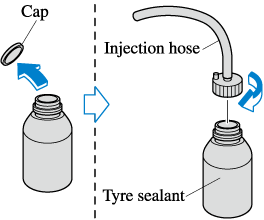
-
Remove the valve cap from the flat tyre. Press the back of a valve core tool to the core of the tyre valve and bleed all the remaining air.
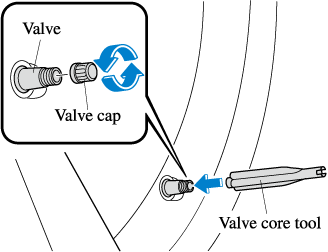
If there is air remaining in the tyre when the valve core is removed, the valve core could fly out. Remove the valve core carefully.
-
Turn the valve core anticlockwise with the valve core tool and remove the valve core.
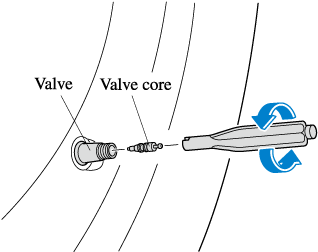
-
Insert the injection hose into the valve.
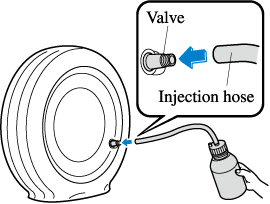
-
Hold the bottom of the bottle upright, squeeze the bottle with your hands, and inject the entire amount of tyre sealant into the tyre.
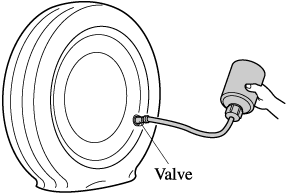
-
Pull out the injection hose from the valve.
The tyre sealant cannot be reused. Purchase a new tyre sealant kit at an Authorised Mazda Repairer.
-
Reinsert the valve core into the valve and turn it clockwise to install it.
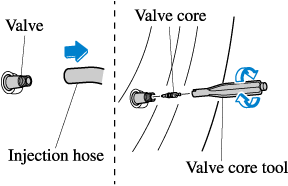
Do not throw away the empty tyre sealant bottle after use. Return the empty tyre sealant bottle to an Authorised Mazda Repairer when replacing the tyre. The empty tyre sealant bottle will need to be used to extract and dispose of the used sealant from the tyre.
-
After that, install the injection hose to the tab of the bottle to prevent leakage of any remaining sealant.
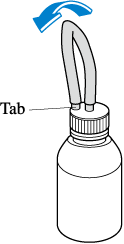
-
Adhere the speed restriction sticker to an area where it can be viewed easily by the driver.
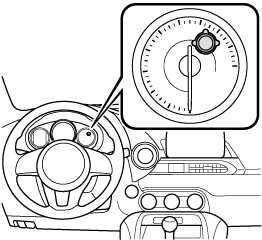
Do not adhere the speed restriction sticker to the padded area on the steering wheel:
Adhering the speed restriction sticker to the padded area on the steering wheel is dangerous because the air bag may not operate (deploy) normally resulting in serious injury. In addition, do not adhere the sticker to areas where warning lights or the speedometer cannot be viewed.
-
Pull out the air compressor hose and the air compressor plug from the air compressor.
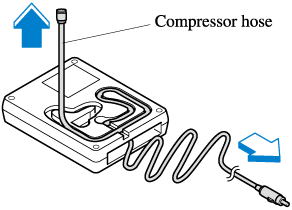
-
Install the air compressor hose to the tyre valve.
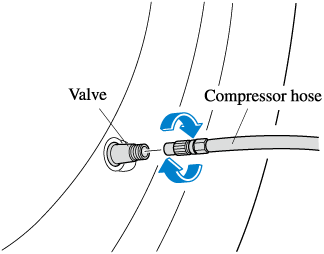
-
Insert the air compressor plug into the accessory socket inside the vehicle and switch the ignition to ACC.
Refer to Accessory Sockets (Search).

When inserting the air compressor plug into or removing it from the accessory socket, make sure that the air compressor switch is off. When turning the air compressor on/off, use the air compressor switch.
-
Turn the air compressor switch on and inflate the tyre carefully to the correct inflation pressure.
-
Check the tyre inflation pressure label driver's door frame for the correct tyre inflation pressure.
-
Do not operate the air compressor for a continuous 10 minutes or longer because using it for long periods could cause a malfunction.
-
If the tyre inflation pressure does not increase, repair of the tyre is not possible. If the tyre does not reach the specified tyre inflation pressure within 10 minutes, it may have received extensive damage. In this case, the repair using the emergency flat tyre repair kit was not successful. Contact an expert repairer (we recommend an Authorised Mazda Repairer).
-
If the tyre has been over-inflated, loosen the screw cap on the air compressor and bleed some of the air out.
-
-
When the tyre inflates to the specified tyre inflation pressure, turn the air compressor switch off, turn the sleeve of the air compressor hose to the left, and pull it out of the tyre valve.
-
Install the tyre valve cap.
-
Put the emergency flat tyre repair kit into the boot.
-
Start driving immediately to spread the sealant in the tyre.
Carefully drive the vehicle at a speed of 80 km/h (50 mph) or less. If the vehicle is driven at a speed of 80 km/h (50 mph) or more, the vehicle may vibrate.
(With tyre pressure monitoring system)
If the tyre is not properly inflated, the tyre pressure monitoring system warning light will illuminate.
-
After driving the vehicle for about 10 minutes or 5 km (3 miles), connect the air compressor to the tyre using Step 17 of the procedure, and check the tyre inflation pressure using the tyre pressure gauge on the air compressor. If the tyre inflation pressure is lower than the specified tyre inflation pressure, turn the air compressor on and wait until it reaches the specified tyre inflation pressure.
If the tyre inflation pressure has decreased below 130 kPa (1.3 kgf/cm2 or bar, 18.9 psi), stop driving and contact an expert repairer (we recommend an Authorised Mazda Repairer):
The repair using the emergency flat tyre repair kit was not successful.
If you see a decrease in the tyre inflation pressure, even if Steps 17 to 24 of the procedure are performed repeatedly, stop driving:
Contact an expert repairer (we recommend an Authorised Mazda Repairer).
Before checking the tyre inflation pressure using the tyre pressure gauge, turn the air compressor switch off.
-
The emergency flat tyre repair is completed successfully if the tyre inflation pressure does not decrease. Carefully drive the vehicle to the nearest expert repairer (we recommend an Authorised Mazda Repairer) immediately and have the flat tyre replaced. Replacement with a new tyre is recommended. If the tyre is to be repaired or reused, consult an expert repairer (we recommend an Authorised Mazda Repairer).
-
If an emergency flat tyre repair has been performed using the emergency flat tyre repair kit, Mazda recommends that the tyre be replaced with a new one as soon as possible. If the tyre is to be repaired or reused, consult an expert repairer (we recommend an Authorised Mazda Repairer).
-
The wheel can be reused if the sealant adhering to it is removed. However, replace the valve with a new one.
-




